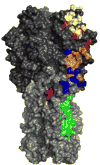Universal influenza virus vaccines and therapeutics: where do we stand with influenza B virus?
- PMID: 29677684
- PMCID: PMC6141316
- DOI: 10.1016/j.coi.2018.04.002
Universal influenza virus vaccines and therapeutics: where do we stand with influenza B virus?
Abstract
The development of a broadly protective or universal influenza virus vaccine is currently a public health priority worldwide. The vast majority of these efforts is exclusively focused on influenza A viruses. While influenza A viruses cause the majority of all influenza cases worldwide, influenza B viruses should not be ignored. Approximately 25% of all influenza cases are caused by influenza B viruses which circulate as two distinct B/Victoria/2/87-like and B/Yamagata/16/88-like lineages. In contrast to popular belief, influenza B cases frequently cause significant morbidity and mortality, especially in children. Similar to influenza A viruses, influenza B viruses drift antigenically and the influenza B components of current vaccines have to be reformulated almost on an annual basis. A broadly protective vaccine against influenza B viruses is therefore urgently needed. Here we review both broadly protective anti-influenza B antibodies as well as the sparse attempts to create a universal influenza B virus vaccine.
Copyright © 2018 Elsevier Ltd. All rights reserved.
Figures



Similar articles
-
Single-replication BM2SR vaccine provides sterilizing immunity and cross-lineage influenza B virus protection in mice.Vaccine. 2019 Jul 26;37(32):4533-4542. doi: 10.1016/j.vaccine.2019.06.043. Epub 2019 Jul 4. Vaccine. 2019. PMID: 31280945 Free PMC article.
-
Generation of DelNS1 Influenza Viruses: a Strategy for Optimizing Live Attenuated Influenza Vaccines.mBio. 2019 Sep 17;10(5):e02180-19. doi: 10.1128/mBio.02180-19. mBio. 2019. PMID: 31530680 Free PMC article.
-
Influenza vaccines: 'tailor-made' or 'one fits all'.Curr Opin Immunol. 2018 Aug;53:102-110. doi: 10.1016/j.coi.2018.04.015. Epub 2018 May 4. Curr Opin Immunol. 2018. PMID: 29734023 Review.
-
Broadly Cross-Reactive, Nonneutralizing Antibodies against Influenza B Virus Hemagglutinin Demonstrate Effector Function-Dependent Protection against Lethal Viral Challenge in Mice.J Virol. 2019 Mar 5;93(6):e01696-18. doi: 10.1128/JVI.01696-18. Print 2019 Mar 15. J Virol. 2019. PMID: 30626682 Free PMC article.
-
Prospects for broadly protective influenza vaccines.Vaccine. 2015 Nov 27;33 Suppl 4:D39-45. doi: 10.1016/j.vaccine.2015.08.053. Epub 2015 Sep 1. Vaccine. 2015. PMID: 26338145 Review.
Cited by
-
Mosaic Hemagglutinin-Based Whole Inactivated Virus Vaccines Induce Broad Protection Against Influenza B Virus Challenge in Mice.Front Immunol. 2021 Sep 16;12:746447. doi: 10.3389/fimmu.2021.746447. eCollection 2021. Front Immunol. 2021. PMID: 34603333 Free PMC article.
-
Characterization of Novel Cross-Reactive Influenza B Virus Hemagglutinin Head Specific Antibodies That Lack Hemagglutination Inhibition Activity.J Virol. 2020 Nov 9;94(23):e01185-20. doi: 10.1128/JVI.01185-20. Print 2020 Nov 9. J Virol. 2020. PMID: 32907980 Free PMC article.
-
The first decade of research advances in influenza D virus.J Gen Virol. 2021 Jan;102(1):jgv001529. doi: 10.1099/jgv.0.001529. J Gen Virol. 2021. PMID: 33211641 Free PMC article. Review.
-
Drug-Fc conjugate CD388 targets influenza virus neuraminidase and is broadly protective in mice.Nat Microbiol. 2025 Apr;10(4):912-926. doi: 10.1038/s41564-025-01955-3. Epub 2025 Mar 17. Nat Microbiol. 2025. PMID: 40097766 Free PMC article.
-
Antibody Responses toward the Major Antigenic Sites of Influenza B Virus Hemagglutinin in Mice, Ferrets, and Humans.J Virol. 2019 Jan 4;93(2):e01673-18. doi: 10.1128/JVI.01673-18. Print 2019 Jan 15. J Virol. 2019. PMID: 30381487 Free PMC article.
References
-
- Krammer F, Palese P. Advances in the development of influenza virus vaccines. Nat Rev Drug Discov. 2015;14:167–182. - PubMed
-
- de Jong JC, Beyer WE, Palache AM, Rimmelzwaan GF, Osterhaus AD. Mismatch between the 1997/1998 influenza vaccine and the major epidemic A(H3N2) virus strain as the cause of an inadequate vaccine-induced antibody response to this strain in the elderly. J Med Virol. 2000;61:94–99. - PubMed
-
- Zost SJ, Parkhouse K, Gumina ME, Kim K, Diaz Perez S, Wilson PC, Treanor JJ, Sant AJ, Cobey S, Hensley SE. Contemporary H3N2 influenza viruses have a glycosylation site that alters binding of antibodies elicited by egg-adapted vaccine strains. Proc Natl Acad Sci U S A. 2017;114:12578–12583. - PMC - PubMed
Publication types
MeSH terms
Substances
Grants and funding
LinkOut - more resources
Full Text Sources
Other Literature Sources
Medical

